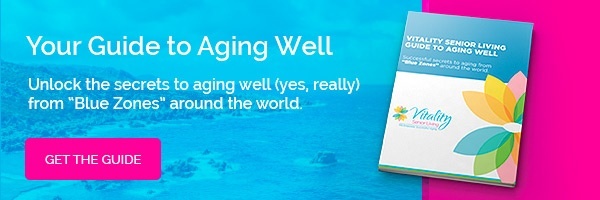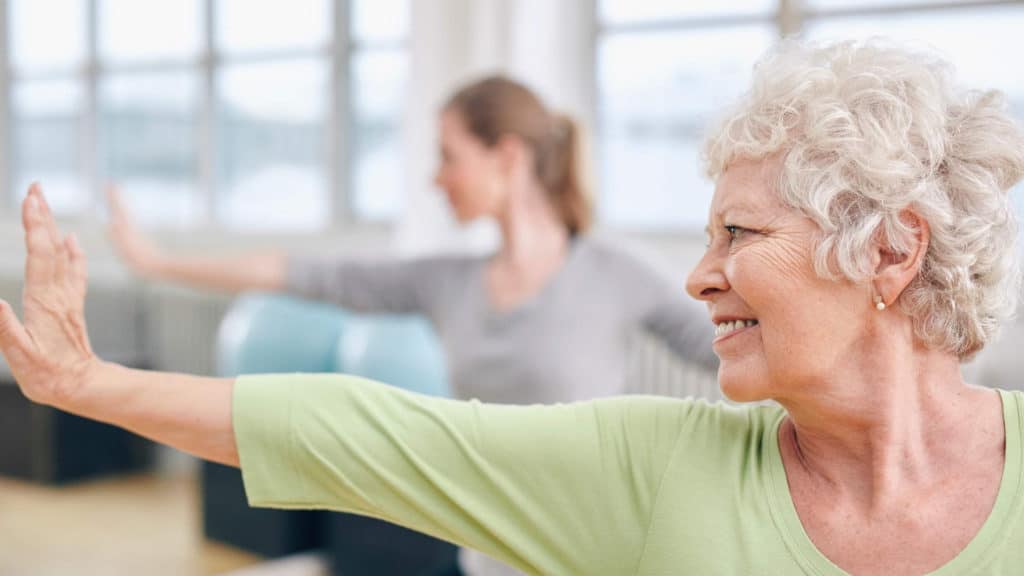These are short chair yoga poses and exercises that can be easily completed at home or in a group setting. They combine breathing awareness with yoga exercises that can be done while sitting in a chair or lying down. If possible, you should wear loose clothing, shirt untucked, but any type of clothing is fine. If you experience any pain, simply skip that exercise. All yoga exercises are gentle, never pushing the body. The goal is to feel relaxed and peaceful.
Coherent Breathing
If you have the time to learn only one technique, this is the one to try. In coherent breathing, the goal is to be aware of your breath and to breathe slowly while mentally counting the lengths of your breaths:
- We’ll begin this breathing exercise counting to 2 as you inhale, pause, and exhale to the count of 2. (With time, as you practice breathing exercises, you may be able to work up to longer breaths, counting to 3, 4, 5, or 6 as you inhale or exhale.)
- Begin to straighten your spine and place your hands on your belly—notice sensations of breathing in your belly. If you are comfortable, close your eyes.
- Slowly breathe in, expanding your belly, to the count of 2.
- Pause.
- Slowly breathe out to the count of 2. Silently say to yourself: “Inhale, 1 and 2 and pause and exhale, 1 and 2 and pause.”
If possible, work your way up to practicing this pattern for five to 15 minutes per day. Do you feel the gentle movements of the in-and-out breath on your belly? There is no right way to feel this; we are just taking a moment to become more familiar with your breathing.
When you are ready, open your eyes, remove your hands from your belly, and just rest in the chair.
Chair Yoga Exercises
Seated Mountain Pose
Mountain pose is sometimes called “samasthiti,” or equal standing. This pose is often practiced at the beginning of a class and between poses as a way to reset and balance the body.

Using a straight-back chair with no arms:
- If you are able, come to the front edge of the chair. Try to keep your spine straight and sit up tall, feet flat on the floor, ankles directly under your knees, hands on your knees—this is called seated mountain pose.
- As you are seated, you want to try to push down into the chair with your lower body and buttocks, while lifting your chest and neck and head up tall, feeling like you are stretching the spine. Pretend there is a big balloon attached to the crown of your head, pulling your head and upper body straight up.
- Your head is level, your eyes looking across the room. Try to focus on some point across the room.
- Take a few minutes to hold this pose, being aware of your breath while seated. Do you feel the subtle movement as you breathe? There is no right or wrong way to feel this—just an awareness.
Overhead Stretch

We’ll coordinate our movement with our breathing:
- While still seated in the chair, take a deep breath through your nose and raise both arms above your head, hands together over your head.
- As you exhale, slowly lower your arms, the palms of your hands together, in front of your heart.
- Repeat this a few times slowly inhaling while you raise both arms and exhaling while you move your hands together in front of your heart.
- Now try spreading your fingers wide apart as you move your arms up and down.
- Notice the air between your fingers.
- Notice how your hands are feeling as you bring them together. Are they feeling warm? Are they feeling cool? There is no right or wrong way here. Go at your own pace—raising and lowering your arms according to your own breathing.
- Notice how you are feeling—your breath, the warmth in your palms.
- Now keep your hands together in front of your chest and rest for a moment.
- It’s okay if your mind wanders—acknowledge that, letting it be and then bringing your mind back to the sensations in your body.
Seated Cat and Cow Stretches

Cat and cow stretches help loosen your spine, and this stretch is also coordinated with your breathing:
- Place your hands face down on top of your legs as in seated mountain pose.
- Now inhale and gently arch your spine as you push your belly and chest forward, looking up slightly toward the ceiling.
- Exhale and gently round your spine, looking slightly down toward your belly button.
- Slowly repeat a few times.
- Inhale and come back to seated mountain position. Take a moment to acknowledge any sensations in your body. Now you’re going to do this movement adding in your arms.
- Inhale and, as you gently arch your spine, extend your arms out to the side as if you were going to give someone a big hug.
- Now slowly exhale, round and cross your arms over your chest, each hand placed against the upper portion of your chest.
- Go at a pace that is comfortable for you.
- Repeat a few times… and gradually bring the movement to a stop.
- Come back to seated mountain pose.
- Close your eyes and bring attention to how you feel in your body—notice what it is like for you.
Neck Stretch

Here is a simple stretch for your neck:
- Take your right hand and reach over your head and hold on to some area on the left side of your head.
- Slowly and gently bring the right side of your head toward your right shoulder, just a small distance.
- Do not do this stretch if it causes you any pain.
- Let your shoulders be relaxed, hold and breathe naturally—be gentle with your neck and head; only stretch if it is comfortable for you.
- Notice how this stretch feels for you.
- On the next exhale, let everything go and come back to seated mountain pose.
- Now with your left hand, reach over to hold on to the right side of your head.
- Gently bring the left side of your head toward your left shoulder.
- Notice how the stretch feels on this side compared to the other side.
- On the next exhale, let everything go and rest in seated mountain pose.
Upper-Body Stretch
This is a gentle stretch for your upper body:
- Stay seated in the chair with your knees bent and your ankles directly below your knees.
- Breathe in as you slowly raise both of your arms up above your head.
- Breathe naturally while keeping your arms above your head.
- If it feels good for your body, you can gently stretch your left arm even higher as if you were climbing a rope, then exhaling while your left arm relaxes a bit and your right arm stretches up even higher.
- If this feels good, you can repeat it a few times, inhaling when you stretch your left arm, exhaling while you stretch your right arm.
- At any point, if your body tells you to do this, bring your hands back down.
When you are ready, slowly lower your arms, rest your arms on your knees, and resume seated mountain pose.
How is your body feeling? Do you feel warmth in your shoulders and arms?
Gentle Seated Twist

- While you are in seated mountain pose, put your left hand on your right knee and your right hand on your right hip
- Take a deep breath in and, as you gently breathe out, gently turn your body toward the right and, if you are able, look over your right shoulder.
- Let’s notice what it is like to breathe in this twist position. Where do you feel your breath in your body? Do you notice any sensations of opening in your body?
- Hold this twist for a few seconds if it is comfortable.
- Notice any sensations of opening in your spine.
- On the next exhale, slowly come out of the twist and return to seated mountain pose.
- Now on the left side.
- Put your right hand on your left knee and your left hand on your left hip.
- If you are able, look over your left shoulder.
- On the next exhale, slowly come out of the twist and return to seated mountain pose.
- While you are in seated mountain pose, take a minute to be aware of your breath. As you breathe in, let yourself feel you are breathing in the energy of the day around you and as you breathe out, say: “Peace to all around us.” (Repeat a couple times.)
And finally, take a moment to congratulate yourself on completing this mindfulness exercise and taking the time out of your day to nurture yourself.




